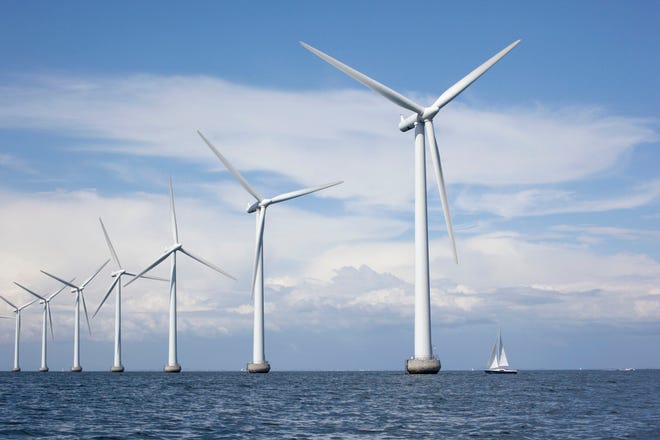- The six companies that bid on the sites off New York and New Jersey have the potential to produce enough electricity to power 2 million homes by 2030.
- The Department of the Interior three-day auction was the highest-grossing energy auction in U.S. history, including oil and gas leases.
- The U.S. lags significantly behind Europe, where wind power now covers 15% of energy demand.
Six companies have agreed to pay a record-breaking $4.37 billion for the right to build wind turbines more than three miles off the coasts of New York and New Jersey, a major milestone for U.S. renewable energy efforts.
The Department of the Interior’s three-day auction ended Friday and was the highest-grossing energy auction in U.S. history, including oil and gas leases.
The six companies that bid on the sites have the potential to produce 5.6 to 7 gigawatts of electricity by 2030, enough to power 2 million homes. The money from the leases will go to the U.S. Treasury.
“It’s a good thing for American consumers and it’s an even better thing for the climate,” said Heather Zichal, CEO of the American Clean Power Association.
CLIMATE POINT:Subscribe to USA TODAY’s free weekly newsletter on climate change, the environment and the weather
Building and installing the turbines will create thousands of jobs, she said.
“It’s the turbines, the ships, the construction workers. And it’s not just on the coasts, it’s jobs for welders and manufacturing positions making the different components across the country,” Zichal said.
The turbines will be sited on 488,000 acres of ocean between Cape May, New Jersey, and Montauk Point, New York.

The sale “makes one thing clear: the enthusiasm for the clean energy economy is undeniable and it’s here to stay,” said Interior Secretary Deb Haaland.
The news comes as urgency grows for shifting U.S. energy production to non-carbon emitting sources. On Monday, top scientists released a devastating report outlining the dangers of human-caused climate change.
The evidence is clear that carbon dioxide, largely produced by burning coal, oil and natural gas, is the main driver of climate change, the report says.
Both New York and New Jersey have set aggressive goals for offshore wind power: New York for 9 gigawatts and New Jersey for 7.5 gigawatts by 2035.
The U.S. Bureau of Ocean Energy Management began the lease analysis process in 2018 and spent years conducting environmental reviews.
FACT CHECK:Wind turbine blades can be recycled, but it rarely happens today
If the Biden administration’s plan to boost offshore wind production reaches its goals, up to 83,000 jobs could be created along with $25 million in annual economic output, the American Clean Power Association said.
The U.S. lags significantly behind Europe, where wind power now covers 15% of energy demand. In 2021, Europe installed offshore turbines that will produce 3.3 gigawatts of power.
Offshore wind energy is still more expensive than onshore wind, which costs between $26 and $50 per megawatt-hour, according to Lazard, a financial advisory firm that publishes annual estimates of the total cost of producing electricity. A typical natural gas powered combined cycle power plant’s electricity costs between $45 and $74 per megawatt-hour.
Currently, Lazard puts the cost of offshore wind at $83 per megawatt-hour, but costs are falling significantly. Bloomberg New Energy Finance, a research firm, predicts offshore wind prices will fall 49% this decade.
The nation’s first commercial-scale offshore wind farm is being built about 12 miles off Martha’s Vineyard in Massachusetts. Its 62 turbines will produce enough power for about 400,000 homes.
And Deepwater Wind has built a five-turbine farm that produces 30 megawatts of power, far off the Rhode Island coast.
Six more such lease auctions are scheduled through 2024, including in the Carolinas, Northern and Central California, the Central Atlantic, Oregon and the Gulf of Maine.
The Department of the Interior is planning for upwards of 2,000 offshore turbines to produce power for 10 million U.S. homes by 2030.

